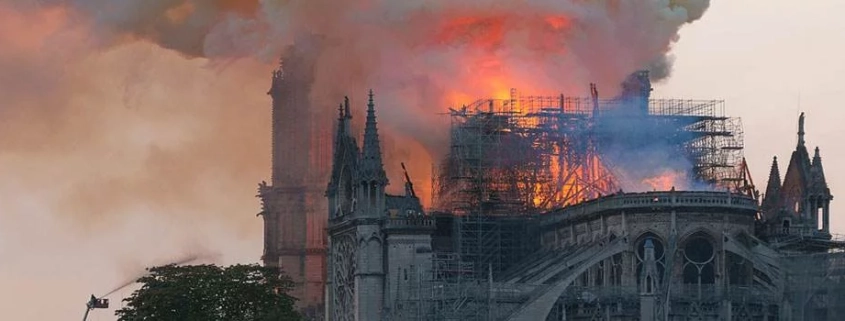Notre-Dame Leadership: Protective Equipment for Professionals
Notre-Dame fire and lead contamination
On April 15, 2019 Notre-Dame fire It started on the building's frame in the late afternoon. The so-called “Forest” – the impressive framework supporting the lead roof and the cathedral's spire (120 m long, 10 m high, required 21 hectares of forest to complete) was engulfed in flames for more than 10 hours. The devastating fire destroyed the frame and roof, caused some of the building's vaults to collapse, and destroyed much of the artwork and artifacts inside the cathedral. caused by this fire from combustion emissions, Notre-Dame’da bulunan yüzlerce ton kurşunun Its melting produced oxides and lead particles. Measured around the cathedral after the disaster lead particle pollution is especially important. The average daily lead presence in Paris was estimated at 5000 micrograms per square metre, while readings after the fire in Notre-Dame and surrounding areas Lead concentrations of 20,000 to 50,000 μg/m2 and above is showing . These very high levels of lead particles hazardous effects on health and the environment may have . These results therefore call for measures to be taken for those living and working at the Notre-Dame de Paris cleanup and reconstruction sites. In mid-summer 2019, local officials began implementing a decontamination plan for the area.
Health effects of lead
Lead is a heavy metal classified as toxic, mutagenic, reproductive and ecotoxic. This element is also considered carcinogenic (by IARC). The danger of lead contamination lies in smoke or particle exposure. If inhaled or swallowed, these particles can have many hazardous effects on health. Acute or chronic poisoning, lead poisoning is called and with a blood lead level of more than 50 μg/L (micrograms per liter of blood) is defined. The symptoms of this disease are many: headache, vomiting, abdominal pain, psychomotor disorders, paralysis, anemia, dysfunction of the gastrointestinal system and kidneys, high blood pressure, male infertility, intoxication of the fetus causing developmental delays and disorders, fatal encephalitis and comma. at lower concentrations before the official threshold for reporting lead poisoning is reached. lead exposure It may also trigger some of these symptoms.
Notre-Dame lead dust danger
The presence of high levels of lead particles around Notre-Dame may lead to lead poisoning in the population living in this area . Bullet inhalation and swallowing of dust The risk of triggering many health disorders is a possibility. Therefore the authorities simple preventative actions advocating (prohibiting public access to contaminated areas, carrying out regular cleaning to prevent contamination, hands and objects in contact with the ground and street furniture should not touch the face or mouth), disinfecting affected areas (including schools, cathedral courtyards, parks and gardens, etc.) and at-risk advocates lead poisoning screening for the population (children, pregnant women).
Beyond the potential danger to the people of Paris, Notre-Dame field the fire broke out for workers at the reconstruction site poses a greater danger. In fact, the building, spared from rubble and flames, lead dust pollution is at its highest level places (up to 1,300,000 μg/m2 lead measured in the front yard). Therefore, work in the field should be especially supervised and in the best security conditions should be carried out. The same applies to workers and others involved in the decontamination of at-risk areas: adequate protective equipment for people chronically exposed to lead dust (especially respiratory protective masks). It is essential to use .
Lead protection equipment
Respiratory protection against lead dust and particles
Lead pollution caused by the Notre-Dame fire poses a real health hazard to workers and individuals on the cathedral site . on the field First safety measure in case of lead exposure lead PPE (personal protective equipment) is to use: One with P3 filter (dust filter cartridge) PAPR mask ( powered air-purifying respirator ). Unlike traditional gas masks, this type respiratory protective equipment It provides effective protection to the user for a long time. Motorized air purifying respirator, It is a positive pressure system that brings clean filtered air to the breathing mask. For example The mask user wearing the Scott Safety Phantom Vision therefore does not have to make a high respiratory effort and can use this type of device for a long time.
Equipped with P3 filter cartridge using a PAPR mask, Against dust and lead particles found at the Notre-Dame site Provides excellent protection. Different types of masks can be attached to a powered air-purifying respirator, but full protection against bullet It is necessary to use a full face mask that protects the eyes from any protrusions and the respiratory tract (preventing lead inhalation and swallowing).
Other lead protective equipment
Personnel working at the Notre-Dame facility or participating in pollution removal efforts prevent lead poisoning for , polluting showers and in the polluting facility disposable overalls Other equipment such as wearing (with disposable underwear) should be used and provided. Some preventive rules should also be followed: do not eat, drink, smoke in contaminated premises, separate work clothes, Preventing the spread of lead particles around Notre-Dame To humidify work areas, filter water and remove dust at ultra-high pressure with suction, descaling gel or surfactant detergent.


